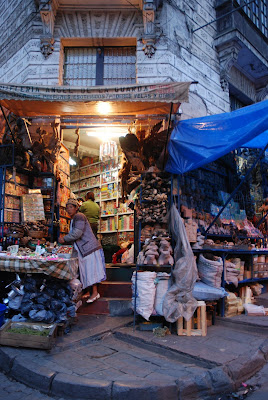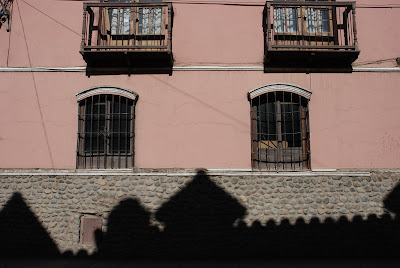La Paz (Peace in English), the highest capital city in the world
(around 4000m), is known as chaotic, dangerous and ugly. But I found
the other side of this city. There is energy under its chaos. There is
the beauty of its setting, the interesting details and its modernity.
Though it did give me a hard time when I was running out of my breath
while walking its steep streets. Or when I found myself waking up in
the middle of the night as the air is too thin. La Paz is definitely
one of my favourite cities in South America.
The stunning setting of the La Paz city in front of the snow-capped Mount Lllampu during the magic hour.

Like a sleepless city.

How bustling this city is!

La Paz during day time.

There are around 1.2millions people living in this city.

The cathedral and Plaza San Francisco where I strolled many times a day.

Local people like to sit in front of the cathedral from day to night.

I like the colourful scarfs which Bolivian women use. They use them to carry anything, food, clothes or children.

Street scene. Behind is a painting about the culture, legend and history of Bolivia.

Traditional dancing.


The mysterious witchcraft market, Mercado de Hechiceria.

Here you can find everything - things for improving your health,
relationship, career, studying or maybe to poison your another half, I
assume.

Scary dried baby Llama.

Potosi (at 4070m, one of the top 3 highest cities in the world), once
famous for its rich deposits of silver, was used as an expression by spaniards - "Es un Potosi", describing anything very rich.
It is heavy and heart-breaking to know how the Spaniards treated the
indigenous people. Thousands of people died inside the silver mines.
I went on a tour to visit the mines of Cerro Rico where local people
are still working for the mineral. Though Silver is very difficult to
discover now.
Once rich in Silver, the mine Cerro Rico is overlooking the city of Potosi.

The mountain looks as if it is spilled with the blood of the miners.

Before we set off to the mine, the guide bought us to the miner's market to buy some gifts for the miners, such as explosive material(!!you can never buy it back home!!),coca leaves and their catalysts, some drinks and cigarettes etc.
This is the explosive material we were going to buy. And we needed to
dress funny in order to enter the mine.

Before entering the mine, the guide showed us how to make a bomb!

She was putting the bomb far enough so as to not hurting ourselves...After about 1minute, the bomb did exploded as planned. But the magnitude of the explosion was out of my expectation. There is a huge roaring sound and the whole ground was shaken.

The view of the city from Cerro Rico.

Finally, we apporached the entrance of the mine.

At first, as my book mentioned, I thought the mine would be as hot as
40 degree. However, when we crawled down one level after another, the
air inside was actually refreshing, although it was very dusty.
It was mainly because we didn't go down to the bottom of the mine.
Down there, due to poor ventilation, temperature could rise up to 40
degree.
The dim-light torch lightened the mine.

The miners faded away into the darkness inside the mine.

Every day, the workers work for at least 8 hours. They don't eat at
all, as coming out of the mine for lunch or snack is time-consuming.
And they eat coca leaves with the catalysts instead. That makes them
forget about hunger and thrist.

The God for the miners, which they believed it can help them to find
silver. They worship him with cigarette, coca leaves and alcohol.

After about 1 hour in the mine, we reached the sunlight again. It is
difficult to imagine how the miners work there day by day without any
sunshine.

It was very difficult to take pictures inside the mines, my camera was
covered in dust (even though I had put protection on it) and my lens
was half-broken after the mine....(it was another story, I will talk
about that when I write about Argentina).
Besides the sad history, Potosi is also world Cultural Heritage site, as it preserved some of the most beautiful buildings in Bolivia,
dating back to the time when the spaniards ruled over the country.
The Cathedral and the geogrous landscape of Potosi.

A look over the city.

I enjoyed staying at the top of the building and watched how the
clouds were changing in the sky.

One day, I followed my book and did some "treasure hunting" for beautiful or speical houses.
Doorway with two lions.

Doorway with suns.

The passage of the seven turns. But I have lost the count. Instead, I
was dispelled by the barking dogs in front of their houses.

Casa de las tres portadas. The camera could not capture the 3 doors
which were widely aparted.

A beautiful door.

A beautiful day in Potosi.

I like the reflection on the wall.

Futher south, near the border of Chile and Argentina, is the Laguna Colorada (4270m). As its name called, it is the colourful lake I have ever seen on the earth. Similar to the 4 lakes district, it is also inhabited by the beautiful flamingos.
Its combination of pink, blue, white and brown are in such a harmony which impressed me a lot.

The flamingos almost merged themselves completely into the lake.



Every day of my journey was just like a dream.

They are another species of flamingos. Note the colour of their feather.

Magic hour in Laguna Colorada. I have never seen pink magic hour before.

Incredibly beautiful.

Struggling out of the warm bed into the icy cold morning, the beautiful sunrise over the lake was already waiting for me.


Around the region of Laguna Colorada, there are geysers which give out sulphur. They looked ugly and dangerous.
The devil feel geysers - Sol de Manana (5000m).
I remembered the morning before I jumped to this 38 degree hot spring was freezing, maybe it was minus 10 degree.

The most splendid view one can ever get in front of a hot spring.

I thought of a delicious cheese cake when I saw this weird mountain.

Driving almost to the meeting point the three countries, Bolivia, Chile and Argentina, we finally approached the last wonder we would see in this journey.
Laguna Verde, with the backdrop of the 5935m Volcan Licancabur.

Getting closer. The colours of the green lake and the blue sky were incredibly unreal.

4WD coming from the direction of Chile.

Salar de Uyuni is the first place and the only one that I desperately want to go back again. During the wet season, while the salt lake is filled with around a few centimeters of rain water, the originally salt crust just turns itself into a gigantic mirror, reflecting the volcanoes, blue sky, white cloud or even the sunset and magic hour.
Just imagining this picture is already very excited for me, how come I could missed the wet season when I went there?
I know my dream for Uyuni is not yet coming to an end...































































